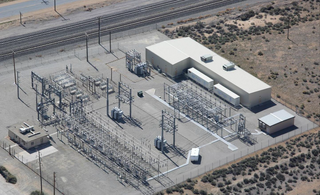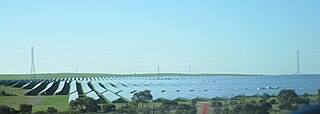
Solar power is a major contributor to electricity supply in Australia. As of December 2023, Australia's over 3.69 million solar PV installations had a combined capacity of 34.2 GW photovoltaic (PV) solar power. In 2019, 59 solar PV projects with a combined capacity of 2,881 MW were either under construction, constructed or due to start construction having reached financial closure. Solar accounted for 12.4% of Australia's total electrical energy production in 2021.

Lake Bonney Wind Farm is a wind farm near Millicent, South Australia, Australia. The wind farm is south of, and contiguous with, Canunda Wind Farm. Both are built along the Woakwine Range - a line of stabilised sand dunes that once were coastal.

The Emu Downs Wind Farm is a 79.2 MW wind farm in Western Australia. It was a 50:50 joint development between Griffin Energy and Stanwell Corporation. The site is approximately 200 kilometres north of Perth, near Cervantes. Construction of the $180 million project commenced in November 2005, and the project was commissioned in October 2006.

Enel Green Power S.p.A. is an Italian multinational renewable energy corporation, headquartered in Rome. The company was formed as a subsidiary of the power generation firm Enel in December 2008. It has operations in five continents generating energy from solar, geothermal, wind and hydropower sources. As of 2024, it manages a capacity of 63,6 GW and has over 1300 plants worldwide.
South Australia is a leader in utility-scale renewable energy generation, and also produces gas and uranium for electricity generation. Gas production is mostly concentrated in the Cooper Basin in the state's north-east. Gas is delivered from these fields by pipeline to users interstate and to Port Adelaide where it fuels three separate gas-fired power plants. Uranium is also mined in South Australia, though nuclear power generation is prohibited nationally. The Olympic Dam mine is the world's single largest known deposit of uranium and represents 30% of the world's total uranium resource. Many utility-scale wind farms and solar farms have been commissioned during the 21st century and geology with potential for geothermal energy has also been identified but is yet to be developed.

The electricity sector in Australia has been historically dominated by coal-fired power stations, but renewables are forming a rapidly growing fraction of supply. In 2021, Australia's electricity production reached 265 TWh, with coal accounting for 52.9% and natural gas for 18.8%. Renewable sources, comprising solar, wind, hydro, and bioenergy with waste, collectively made up 26.7% of the total electricity generation mix.

A battery storage power station, or battery energy storage system (BESS), is a type of energy storage power station that uses a group of batteries to store electrical energy. Battery storage is the fastest responding dispatchable source of power on electric grids, and it is used to stabilise those grids, as battery storage can transition from standby to full power in under a second to deal with grid contingencies.
Kennedy Energy Park is a wind, solar and storage hybrid power station approximately 20 km south east of Hughenden and 290 km southwest of Townsville in Queensland.
The Hornsdale Wind Farm is an electricity generator in the locality of Hornsdale in the south-west of the Narien Range, north of Jamestown, South Australia. It consists of 99 wind turbines with a generation capacity of 315 megawatts (422,000 hp). The plant is owned and operated by Neoen, a French renewable energy company.
Aurora Solar Thermal Power Project was a planned solar power tower solar thermal power plant to be located north of Port Augusta in South Australia. It was planned to generate 150 MW of electricity after it was completed in 2020. Storage capacity would have been up to 8 hours at full power. The facility was expected to produce 495 GWh of electricity annually. It was to be 30 kilometres (19 mi) north of Port Augusta on Carriewerloo Station.
The Lincoln Gap Wind Farm is a wind farm in the vicinity of Lincoln Gap on northeastern Eyre Peninsula in South Australia, Australia. It consists of 59 wind turbines and generates a total of 212 MW of electricity. Construction began in late 2017 and was initially expected to be commissioned in late 2018. Construction was delayed in July 2018 when unexploded ordnance was discovered on the site, left from historic military testing. The site is not far from the Cultana Training Area.

The Tailem Bend Solar Power Farm is a solar power farm near Tailem Bend in South Australia. It has 108MW of generation capacity but is limited to supplying 95MW to the national grid. An additional 85MW is proposed in stage 2. It is developed and owned by Singapore-based Vena Energy, a new name for the former Equis Energy following acquisition by Global Infrastructure Partners in January 2018. The output will be sold to Snowy Hydro for retail sale under its Lumo Energy brand. Stage 2 is also expected to provide battery storage.
Solar River Project is a proposed photovoltaic power station planned to be built near Robertstown in South Australia. The project received development approval from the Government of South Australia in June 2018 and was expected to start construction early in 2019. However, as of November 2021, the project was still proposed to be constructed, but work on site was not expected until at least the second half of 2022.
The Dalrymple ESCRI battery is a 30 MW / 8 MW·h grid-connected battery array near Stansbury on Yorke Peninsula in South Australia. Its role is to provide improved reliability and stability to the electricity network on Yorke Peninsula and South Australia.
Kiamal Solar Farm is a photovoltaic power station under construction north of Ouyen in western Victoria, Australia. Stage 1 is expected to be completed by the end of 2019. It is owned by Total Eren, a renewable energy subsidiary of TotalEnergies When completed, stage 1 at 256MW will be Victoria's largest solar farm. Construction began in October 2018. It has energy offtake agreements with Mars Australia, Flow Power and Alinta Energy.
The Port Augusta Renewable Energy Park is a combined wind and solar farm under construction south of Port Augusta in South Australia, Australia. The solar farm is planned to be at the northern end of the site, west of the Augusta Highway and south of Sundrop Farms. The wind turbines will be on both sides of the Augusta Highway, extending south as far as the road to Horrocks Pass. Construction formally started in October 2020 and is estimated to take about 18 months to complete. The total site is about 5,400 hectares.







